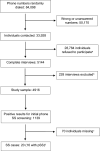Prevalence of Sjögren's syndrome in the general adult population in Spain: estimating the proportion of undiagnosed cases
- PMID: 32606345
- PMCID: PMC7327007
- DOI: 10.1038/s41598-020-67462-z
Prevalence of Sjögren's syndrome in the general adult population in Spain: estimating the proportion of undiagnosed cases
Abstract
To estimate the prevalence of Sjögren's syndrome (SS) in the adult Spanish population we performed a population-based multicenter cross-sectional study. Cases were defined by the American-European Consensus Group criteria proposed in 2002. A total of 4,916 subjects aged 20 years or over were included. The estimated prevalence of SS (including primary and secondary forms) in the adult population in Spain was 0.33% (95% CI 0.21-0.53). Extrapolating to the total population of the country aged ≥ 20 years (around 37.7 million persons), there would be around 125,000 cases of SS in Spain. Considering only primary SS, the estimated prevalence was 0.25% (95% CI 0.15-0.43) or 1 person in 400. The prevalence of primary SS in Spain is comparable to that reported in other European studies with a similar design and diagnostic criteria. Based on these results, primary SS could not be considered a rare (orphan) disease. Only 50% of cases had already been diagnosed with SS prior EPISER 2016 study, confirming the existence of a non-negligible proportion of undiagnosed cases in the general population.
Conflict of interest statement
The authors declare no competing interests.
Figures


References
-
- Mariette X, Criswell LA. Primary Sjögren's syndrome. N. Engl. J. Med. 2018;378:931–939. - PubMed
-
- Nocturne G, Mariette X. Sjögren syndrome-associated lymphomas: An update on pathogenesis and management. Br. J. Haematol. 2015;168:317–327. - PubMed
-
- Maldini C, et al. Epidemiology of primary Sjögren's syndrome in a French multiracial/multiethnic area. Arthritis Care Res (Hoboken). 2014;66:454–463. - PubMed
-
- Valim V, et al. Primary Sjögren's syndrome prevalence in a major metropolitan area in Brazil. Rev. Bras. Reumatol. 2013;53:24–34. - PubMed

